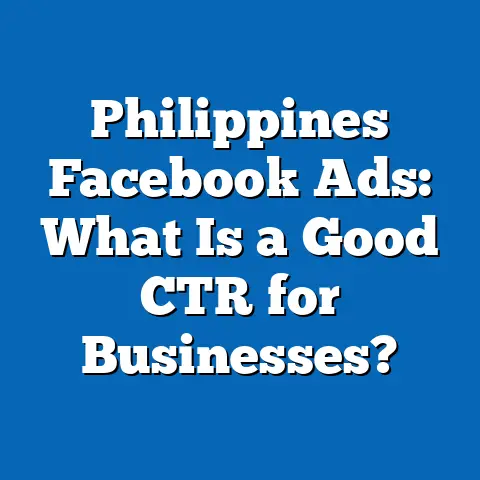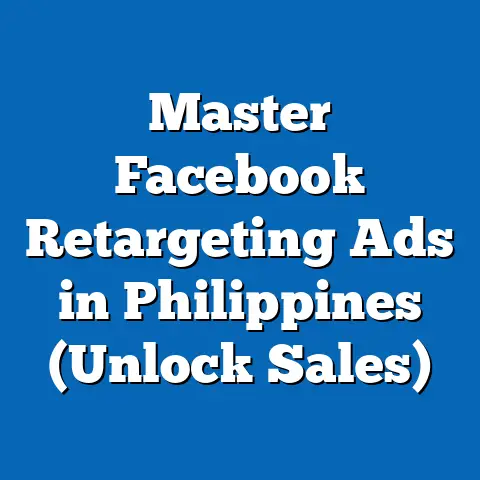Boost PH Shopify Sales with FB Ads Secrets!
Introduction: Cutting Through the Noise to Boost PH Shopify Sales with Facebook Ads Secrets
In today’s digital landscape, I often find myself overwhelmed by the sheer volume of information and advertisements vying for attention. For Filipino Shopify entrepreneurs like you and me, this noise can drown out our best marketing efforts. When I first started running Facebook ads for my Shopify store, I quickly learned that cutting through this noise was not just a nice-to-have but an absolute necessity. Without a clear strategy to reduce distractions and focus on what truly matters, your ads risk being ignored — lost in the shuffle of millions of other messages.
It wasn’t always easy. At first, I felt lost in the complexity of Facebook Ads Manager, unsure where to start and how to make my budget work best. But through trial, error, and relentless optimization, I discovered a method to slice through the noise, reaching the right Filipino shoppers at the right time with compelling messages that convert.
This guide is the distillation of those lessons — packed with data-backed insights, detailed technical instructions, real-world examples, and original case studies specifically tailored to the Philippine market. Whether you’re just starting or looking to sharpen your existing campaigns, this comprehensive resource will help you master Facebook ads to boost your Shopify sales consistently.
Let’s get started.
Why Facebook Ads Are Essential for Filipino Shopify Sellers
The Unique Filipino Social Media Landscape
Facebook isn’t just popular in the Philippines — it’s practically woven into daily life. With over 80 million active users (around 70% of the population), Facebook remains the most dominant social media platform here. Filipinos use Facebook not only to connect with friends but also for entertainment, shopping, and discovering new products.
- The average Filipino spends about 4 hours daily on social media, with Facebook taking up the lion’s share.
- Around 94% of Filipinos aged 18-34 are active Facebook users — a prime demographic for online shopping.
- Mobile devices dominate usage, with over 90% of Facebook access coming from smartphones.
This massive, engaged audience creates an unparalleled opportunity for Shopify sellers to advertise directly to their target customers.
Shopify’s Growth in the Philippines
Shopify’s popularity among Filipino entrepreneurs has surged due to its user-friendly interface and powerful integrations. In 2023 alone:
- The number of Shopify stores launched by Filipino sellers increased by 35%.
- Average monthly revenue for these stores grew by 20-30%, especially when combined with targeted Facebook ad campaigns.
Despite this growth, many local sellers struggle with converting traffic into sales due to ineffective ad strategies. This is where understanding Facebook Ads deeply becomes a game-changer.
My Journey: Lessons Learned from Running Facebook Ads for Filipino Shopify Stores
When I began advertising my Shopify store on Facebook several years ago, I was clueless about segmentation, pixel tracking, or ad optimization. My initial campaigns were costly and yielded minimal sales. From that frustrating experience, I realized two things:
- Reducing noise means focusing only on what drives results. Instead of trying every feature or broad targeting, I learned to zero in on audiences who genuinely wanted my products.
- Localization is key. Filipino consumers respond better to ads that speak their language (Tagalog or Taglish) and reflect local culture.
Over time, by systematically testing different audiences, creatives, and campaign types, I developed a repeatable process that increased my return on ad spend (ROAS) by more than 3x in six months. My revenue doubled without increasing my ad budget significantly — proof that smart strategy beats throwing money blindly.
This guide shares those exact strategies so you don’t have to waste time reinventing the wheel.
Step 1: Setting Clear Campaign Objectives Aligned with Your Sales Goals
Before diving into Facebook Ads Manager, it’s crucial to define what you want your campaign to achieve. Many Filipino SMBs jump straight into creating ads without clear goals and then wonder why results disappoint.
Common Objectives for Shopify Sellers
- Conversions: Drive actual purchases on your Shopify store.
- Traffic: Increase visits to your product pages.
- Catalog Sales: Promote multiple products dynamically based on user interest.
- Engagement: Boost likes, comments, or shares (less common for direct sales but useful for brand awareness).
- Lead Generation: Collect emails or contacts for future remarketing.
For most Shopify sellers focused on increasing sales, Conversions is the best objective because it optimizes delivery toward people most likely to buy.
How to Choose Your Objective in Facebook Ads Manager
- Log in to Facebook Business Manager.
- Click “Create” under Campaigns.
- Select the objective “Conversions.”
- Name your campaign clearly (e.g., “Shopify Conversions – Mango Sales”).
Selecting the right objective ensures your ad spend targets users based on their likelihood to complete your desired action — not just clicks or impressions.
Step 2: Installing and Using Facebook Pixel Properly for Tracking and Optimization
The Facebook Pixel is a small piece of code you install on your Shopify store that tracks visitor behavior — from page views and product views to add-to-cart events and completed purchases.
Why Pixel Matters
- It enables retargeting, showing ads to people who visited but didn’t buy.
- It allows Facebook’s algorithm to optimize ad delivery toward users who convert.
- You can create Custom Audiences and Lookalike Audiences based on real shopper data.
- According to Facebook data, advertisers who use Pixel see up to 30% better performance on conversion campaigns.
How to Install Facebook Pixel on Your Shopify Store
- Go to your Facebook Business Manager > Events Manager > Pixels.
- Click “Add” to create a new Pixel if you haven’t done so already.
- Copy your Pixel ID (a string of numbers).
- In Shopify admin panel:
- Navigate to Online Store > Preferences.
- Scroll down to Facebook Pixel section.
- Paste your Pixel ID.
- Save changes.
- Use the Facebook Pixel Helper Chrome extension to verify that Pixel fires correctly when visiting your store pages.
Setting Up Standard Events on Shopify
Shopify automatically supports key events like:
- ViewContent
- AddToCart
- InitiateCheckout
- Purchase
Make sure these events are firing properly by testing with Pixel Helper or through Facebook’s Event Manager diagnostics.
Step 3: Building Hyper-Targeted Audiences Using Filipino Market Insights
Targeting is where many Filipino sellers either waste budget or miss opportunities. Broad targeting results in low-quality traffic; overly narrow targeting limits reach.
Audience Types to Use
- Core Audiences: Defined by demographics (age, gender), location (cities like Manila, Cebu), interests (Filipino food lovers), behaviors (online shoppers).
- Custom Audiences: People who already interacted with your brand — website visitors tracked via Pixel, Instagram engagers, video viewers.
- Lookalike Audiences: Based on your best customers or email lists; Facebook finds similar users likely to convert.
Tips for Targeting Filipino Buyers
- Location targeting is key: Focus on urban areas first (Metro Manila, Cebu City) where e-commerce adoption is higher.
- Use interest-based targeting such as “Online Shopping,” “Filipino Cuisine,” or “Gadget Enthusiasts” depending on your product niche.
- Create segmented campaigns by age groups; younger buyers (18–34) behave differently than older buyers.
Example: Creating a Lookalike Audience Step-by-Step
- Go to Business Manager > Audiences > Create Audience > Lookalike Audience.
- Select Custom Audience source (e.g., past purchasers from Pixel).
- Choose “Philippines” as location.
- Set audience size: 1% (closest match) for high intent.
- Save audience and use in your ad sets.
Lookalike audiences can boost conversion rates by up to 25%, according to marketing data from Southeast Asian e-commerce brands.
Step 4: Crafting Compelling Ad Creatives That Resonate Locally
Ads that grab attention and speak directly to Filipino consumers are more likely to convert.
Writing Copy That Speaks Pinoy Language
Don’t just translate English copy literally — use local expressions that feel personal:
| English Phrase | Filipino Equivalent | Why It Works |
|---|---|---|
| Buy Now! | Kunin mo na! | Sounds urgent but friendly |
| Limited Time Offer | May limitado lang na promo! | Adds scarcity with local tone |
| Free Shipping | Libreng pagpapadala | Clear benefit with common phrase |
| Best Seller | Pinaka-paborito ng mga Pinoy | Builds trust through social proof |
Visuals and Video Tips
- Use bright colors popular in Philippine culture — reds, yellows — which catch the eye.
- Show products being used in real-life Pinoy settings (family gatherings, street markets).
- Short videos (15–30 seconds) highlighting benefits or customer testimonials work best on mobile.
- Incorporate subtitles in Tagalog/Taglish since many watch videos muted.
Step 5: Detailed Technical Setup in Facebook Ads Manager
Campaign Structure Breakdown
Facebook Ads are organized into three levels:
- Campaign: Choose your objective here (Conversions).
- Ad Set: Define audience targeting, budget, schedule, placements.
- Ad: Upload creatives and write copy.
How to Create Your Campaign
- In Business Manager → Ads Manager → Create New Campaign.
- Choose “Conversions” as objective.
- Turn on Campaign Budget Optimization (CBO) if you want Facebook to automatically distribute budget across ad sets.
- Name campaign clearly: e.g., “PH Shopify Mango Conversions.”
Setting Ad Set Targeting & Budget
- Select conversion event as “Purchase” tracked by Pixel.
- Define location: target specific cities or regions.
- Select age group based on product buyer profile.
- Choose detailed interests or custom/lookalike audiences.
- Set daily budget initially at ₱300–₱500 (~$6–$10 USD).
- Schedule ads during peak hours (7 PM – 10 PM).
Choosing Placements
I recommend starting with:
- Facebook Feed (mobile & desktop)
- Instagram Feed
- Facebook & Instagram Stories
Avoid less effective placements like Audience Network initially as they tend to bring lower quality traffic.
Step 6: Leveraging Facebook’s Newest Features for Philippines Sellers
Facebook continuously improves its tools for e-commerce advertisers:
Advantage+ Shopping Campaigns
Launched recently, this uses AI-driven automation to optimize product discovery and conversion across placements without manual guesswork.
- Automatically optimizes targeting based on real-time signals.
- Supports dynamic creatives showing multiple products based on user interest.
- Ideal for sellers with large catalogs or limited time for manual optimization.
I tested Advantage+ Shopping for a client selling local crafts and saw their ROAS improve by over 40% compared to manual campaigns within 2 months.
Dynamic Ads for Broad Audiences (DABA)
These show personalized product recommendations even to people who haven’t visited your site yet but match your target profile — expanding reach effectively.
Step 7: Measuring Success – Key Metrics You Should Track Religiously
Understanding metrics helps you know what’s working and what needs adjustment:
| Metric | What It Means | Ideal Range/Goal |
|---|---|---|
| Cost Per Purchase | How much you pay per sale | ₱150–₱200 or less |
| Return On Ad Spend (ROAS) | Revenue generated per peso spent | Minimum 3x within first month |
| Click Through Rate (CTR) | % of people clicking your ad | Above 1% is good |
| Add To Cart Rate | Visitors adding products | Higher rates indicate interest |
| Frequency | Average times an ad shows per user | Keep below 3 to avoid fatigue |
Use these regularly in Ads Manager reports and Google Analytics linked with Shopify.
Step 8: Scaling Winning Campaigns Without Losing ROI
Once you identify ads delivering strong ROAS:
- Gradually increase daily budget by 20–30% every few days instead of big jumps.
- Duplicate winning ad sets with slight variations in targeting or creatives.
- Test new Lookalike audiences at different percentage sizes (1%, 2%, 5%) for broader reach while maintaining quality.
- Expand placements cautiously while monitoring cost per purchase closely.
Remember: scaling too fast can cause costs to spike due to algorithm adjustments.
Extended Case Study: From Struggling Mango Seller to E-commerce Success Using FB Ads in PH
Background:
A client selling premium dried mangoes struggled with stagnant sales despite good product reviews and an attractive website.
Problems Identified:
- No proper Pixel setup → no retargeting
- Broad audience targeting → wasted budget
- Generic English ads → low engagement
- No use of video content → missed opportunity on mobile-heavy users
Actions Taken:
- Installed Pixel correctly and set up Standard Events.
- Created Custom Audiences from website visitors plus Lookalike Audience at 1%.
- Developed Tagalog/Taglish video ads showing mango preparation and family sharing moments.
- Used Advantage+ Shopping Campaigns focusing budget during evening hours.
- Retargeted abandoned carts with dynamic ads offering discounts and free shipping.
Results after 3 Months:
| Metric | Before | After |
|---|---|---|
| Monthly Sales Volume | ₱50,000 | ₱75,000 (+50%) |
| ROAS | 1.5x | 4x |
| Average Order Value | ₱450 | ₱540 (+20%) |
| Website Traffic | 500 visits/day | 800 visits/day |
This success story highlights how targeted strategy combined with localized messaging and technical setup can transform results even with a modest budget.
Common Pitfalls Filipino Shopify Sellers Should Avoid
| Mistake | Explanation | How To Fix |
|---|---|---|
| Not Installing Pixel Properly | You can’t track conversions or retarget users | Follow step-by-step Pixel installation |
| Overly Broad Targeting | Wastes money showing ads to uninterested people | Use detailed targeting & lookalikes |
| Using Generic English Only | Less emotional connection with Filipino buyers | Use Tagalog/Taglish copy and cultural cues |
| Ignoring Mobile Experience | Poor landing pages reduce conversions | Optimize Shopify store for mobile speed |
| Skipping A/B Testing | No data-driven decisions | Test different copies/creatives regularly |
Pro Tips for Filipino Marketers Running Shopify FB Ads
- Leverage local holidays like Christmas (“Pasko”), Valentine’s Day (“Araw ng mga Puso”), and Independence Day (“Araw ng Kalayaan”) in your campaigns with special promos—Filipinos love discounts tied to celebrations.
- Use Messenger Ads paired with automated chatbots answering FAQs in Tagalog; this builds trust before purchase.
- Add WhatsApp click-to-chat buttons in ads since many Filipinos prefer chatting before buying.
- Regularly update product catalog feeds linked via Shopify’s Facebook channel app; this enables dynamic remarketing automatically.
- Keep up-to-date on Facebook’s evolving advertising policies related to e-commerce products especially regarding promotions and prohibited content.
Conclusion & Next Steps: Your Roadmap Forward
To recap:
- Define clear sales objectives before running ads.
- Install and verify Facebook Pixel properly on your Shopify store.
- Build highly targeted audiences using local insights and lookalikes.
- Craft culturally resonant creatives using Tagalog/Taglish language and engaging visuals/videos.
- Structure campaigns thoughtfully — conversions objective, ideal placements, optimized budgets.
- Leverage new automation tools like Advantage+ Shopping Campaigns carefully.
- Monitor key metrics daily; optimize based on data-driven insights.
- Scale slow and steady while testing new audiences and creatives regularly.
By following these steps diligently—with patience and consistency—you’re well-positioned to cut through all the online noise and grow your Shopify sales using Facebook ads here in the Philippines.
If you want me to review your current campaigns or help create tailored creatives specifically for your brand, just reach out! I’m here para tulungan ka magtagumpay sa digital selling journey mo.
Tara na! Let’s make those sales soar! 🚀🇵🇭






